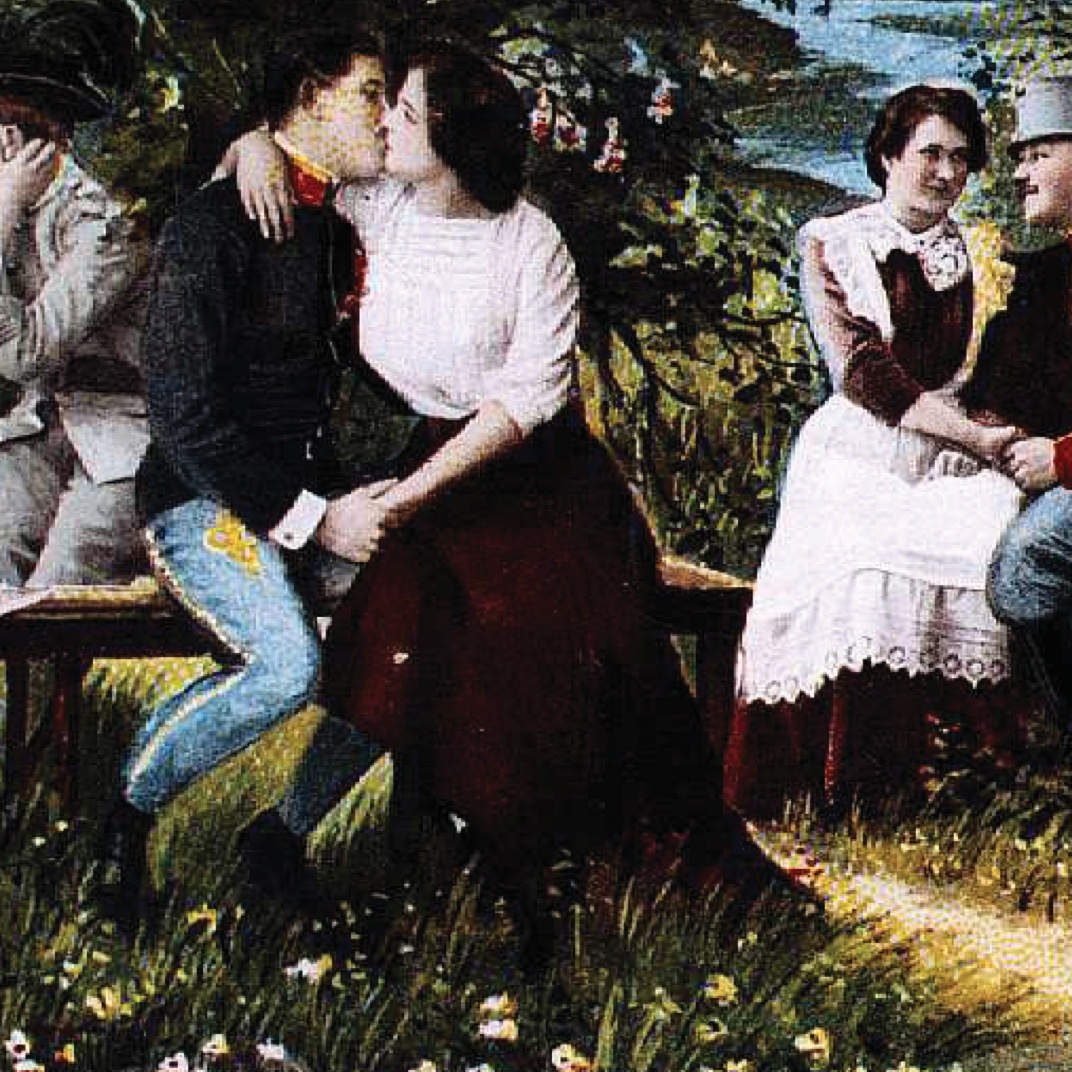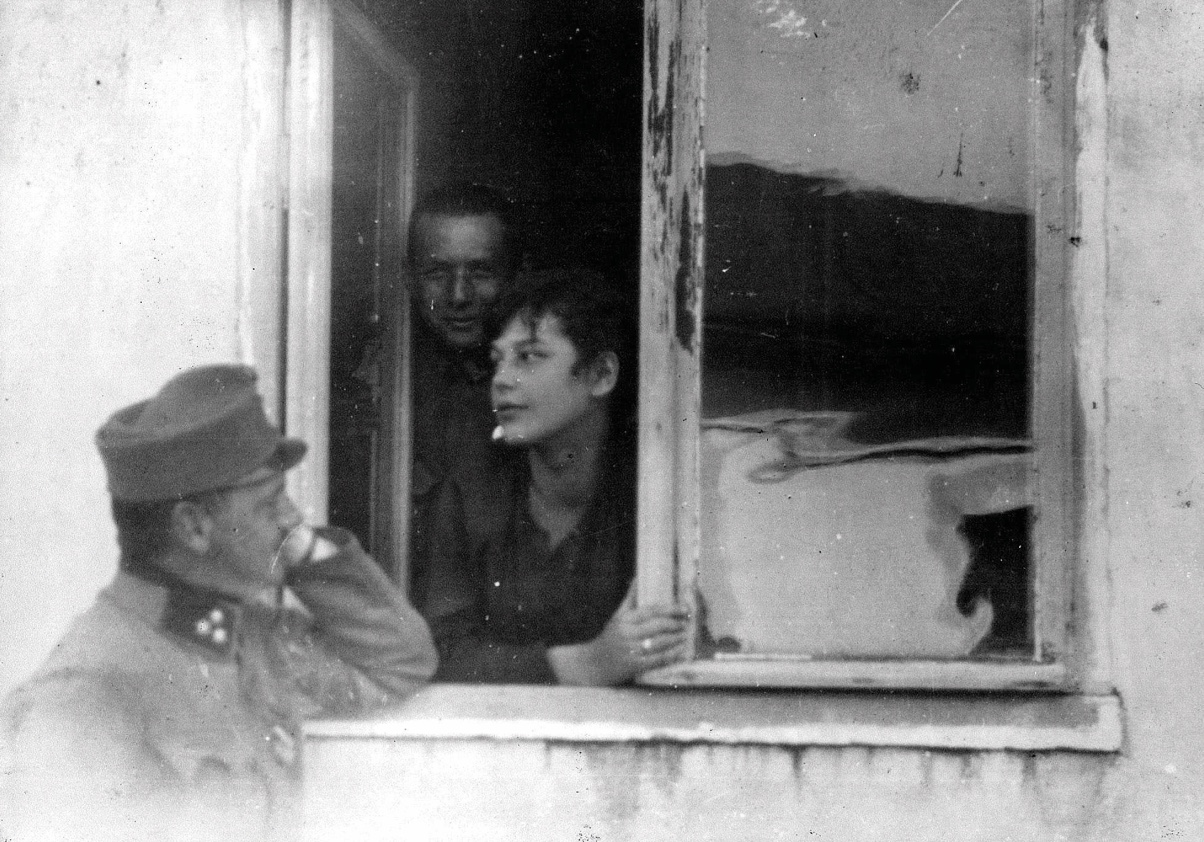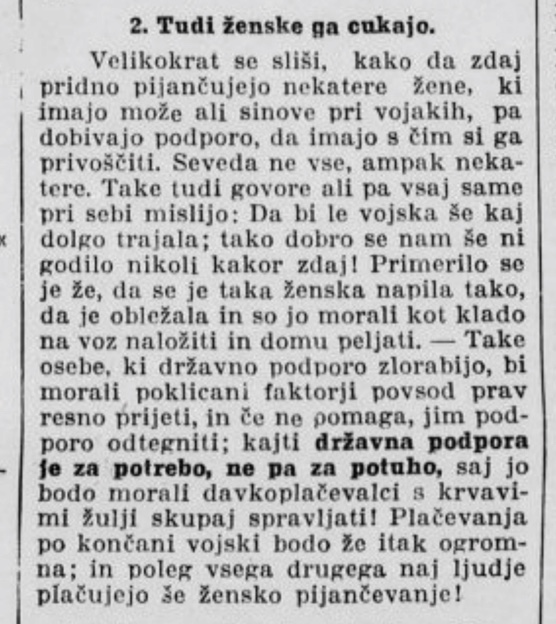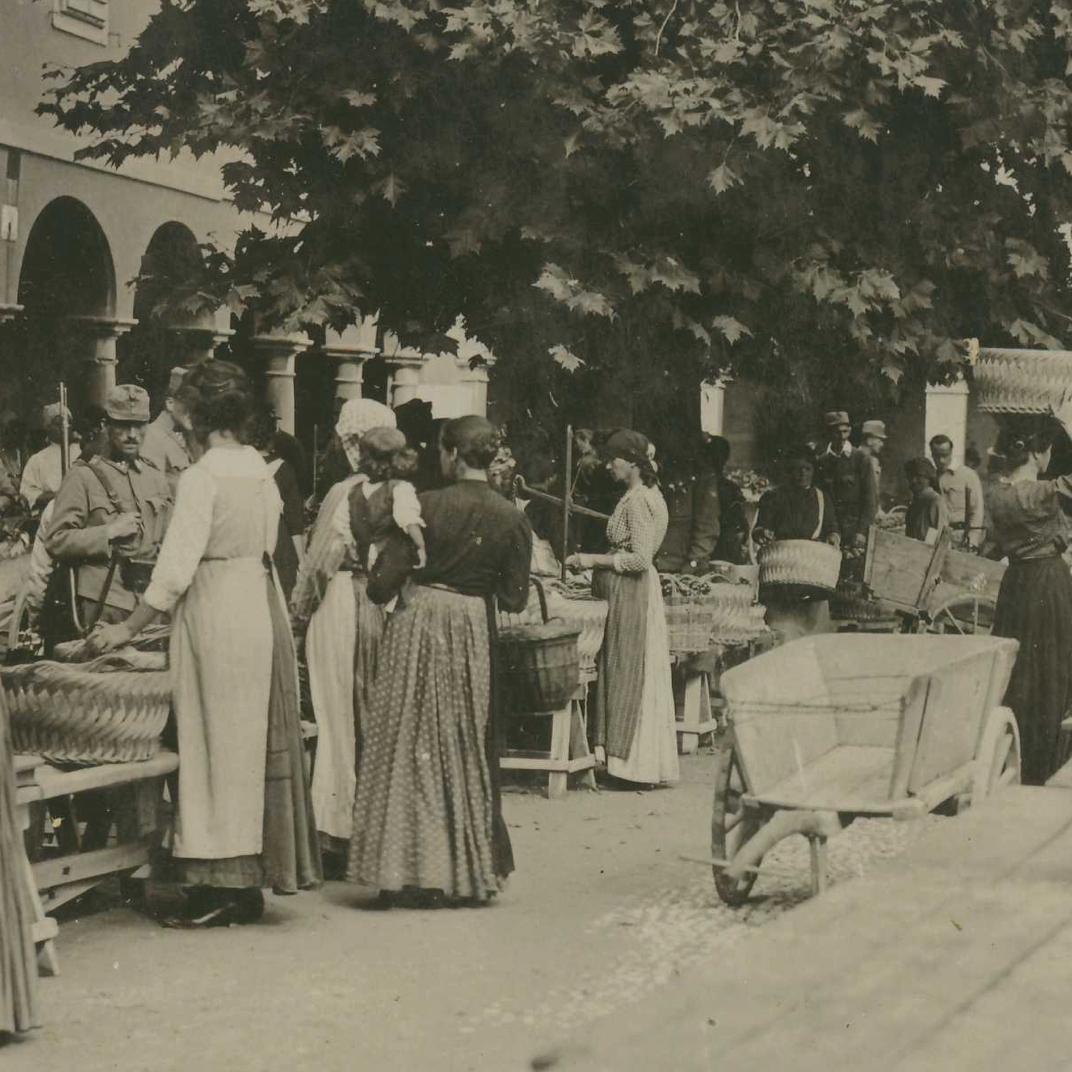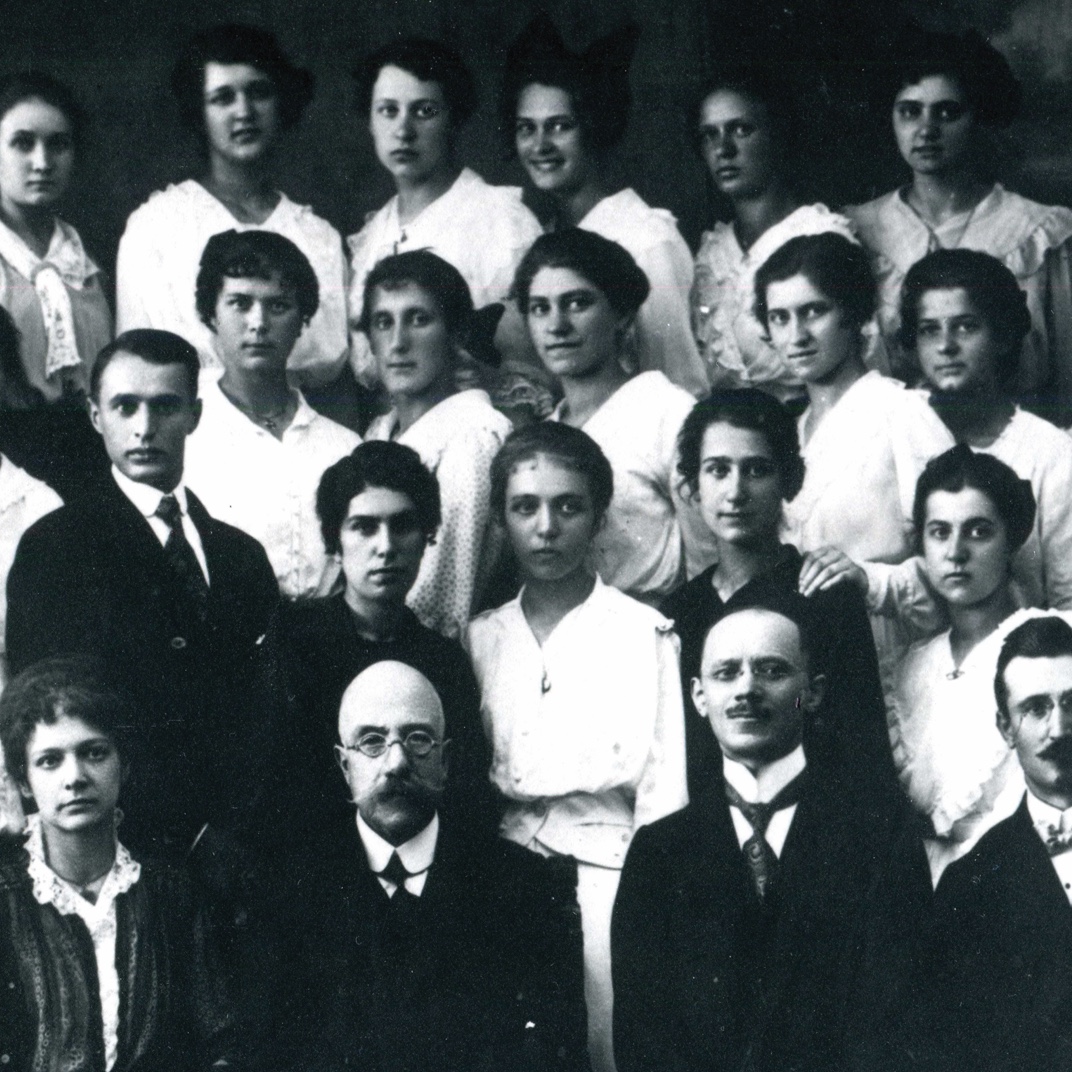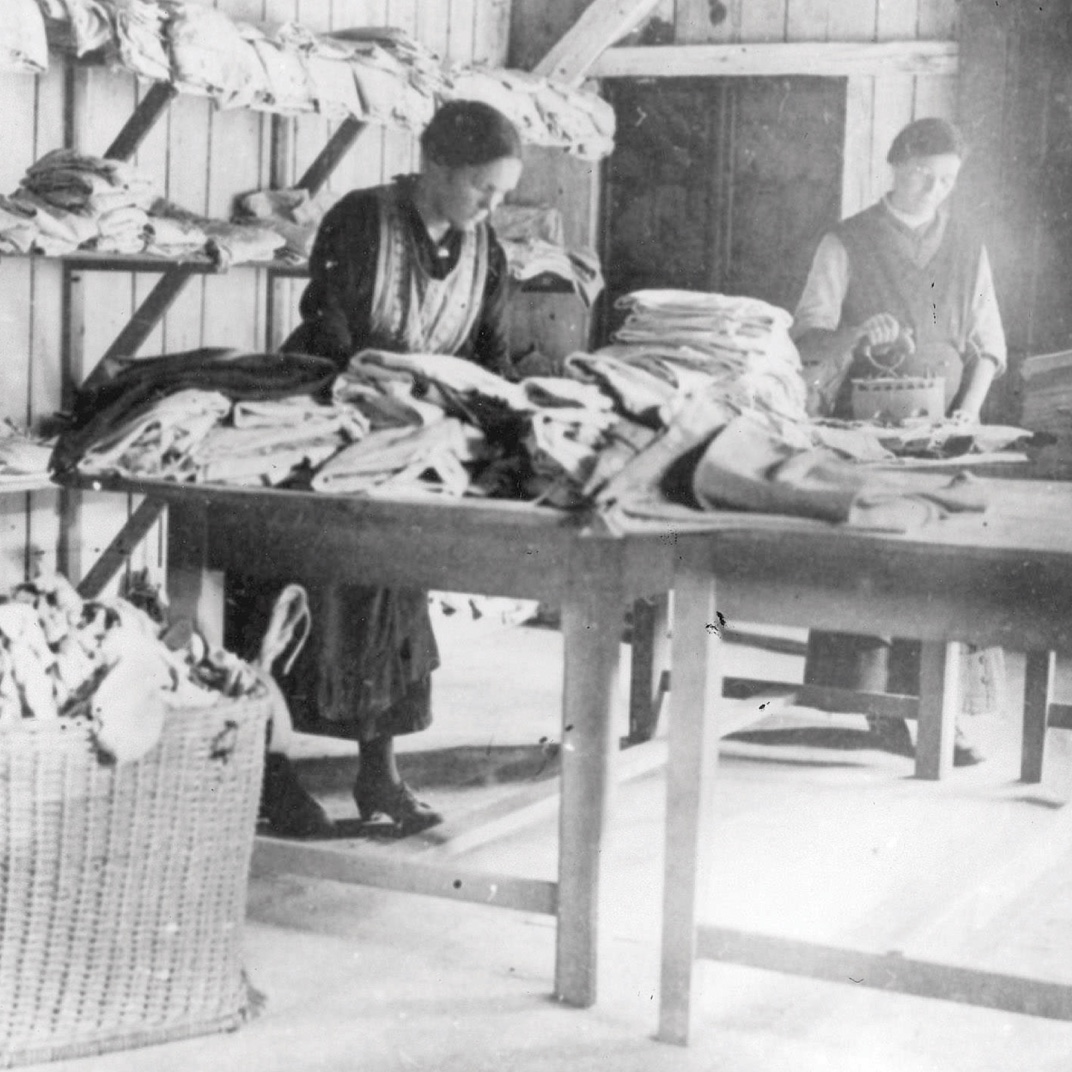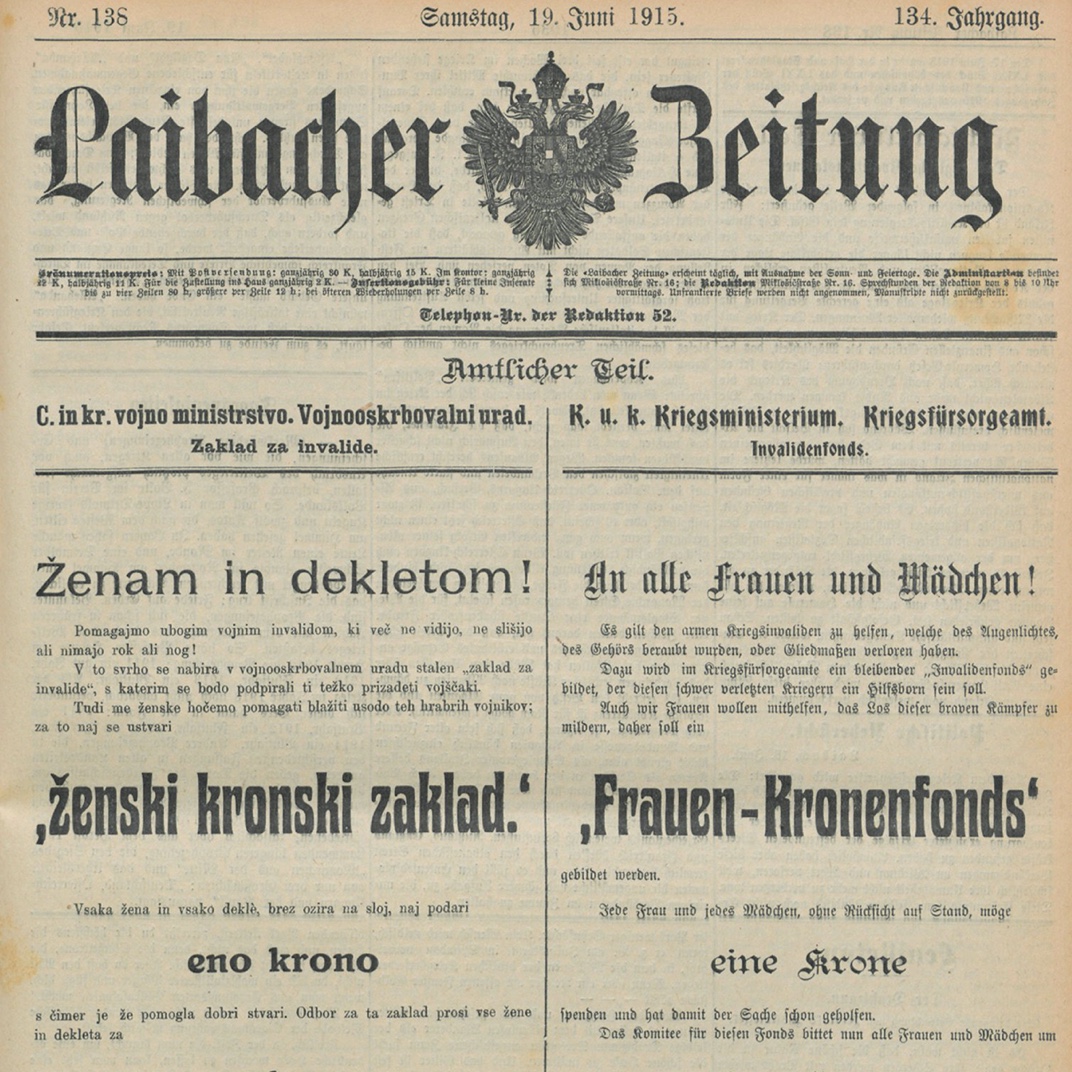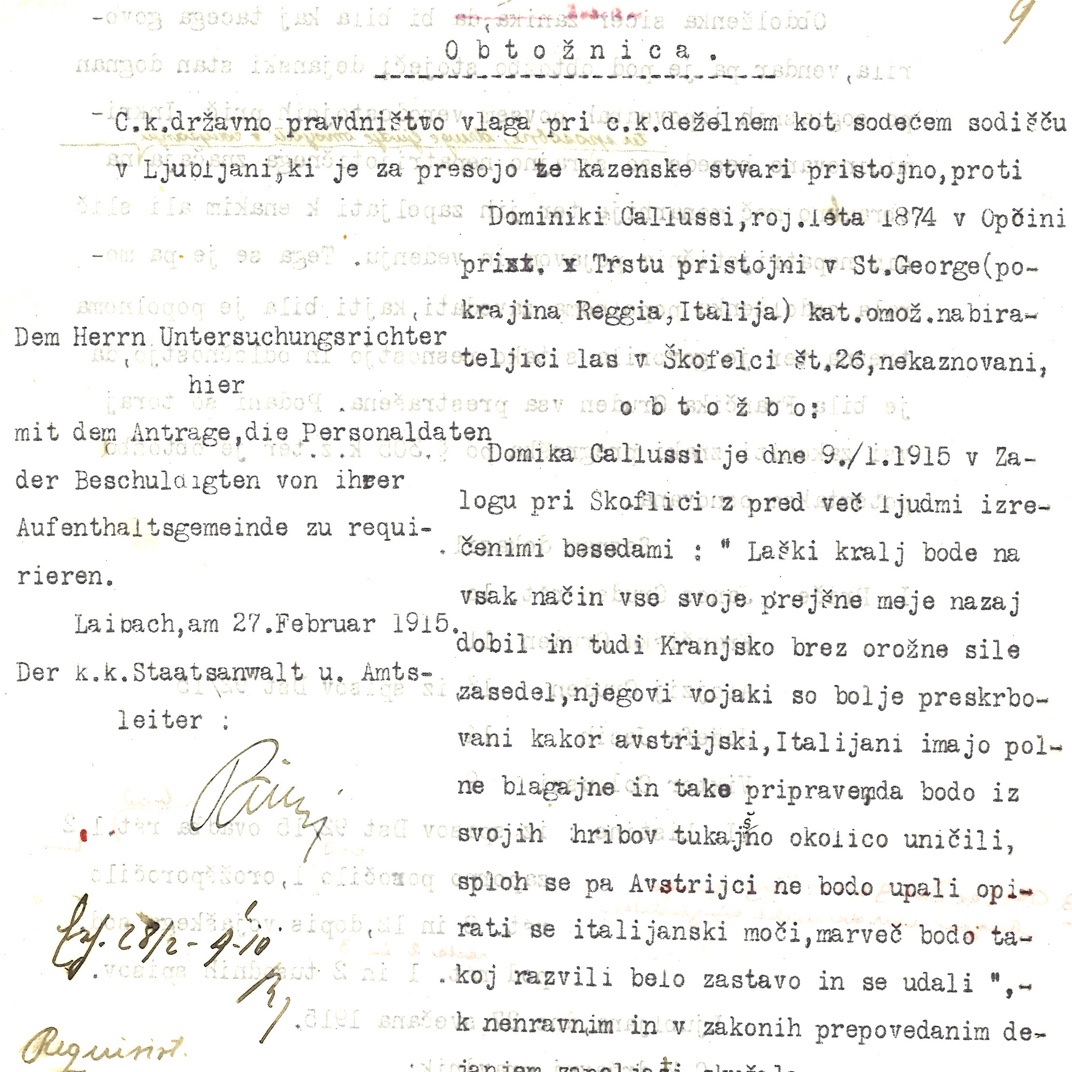Women in the Hinterland of the Isonzo Front
The wave of mass enthusiasm for the war subsided after the first months of combat. The war reared its cruel and blood-stained head in Europe’s battlefields. The number of fallen soldiers grew month by month. The military machine required new conscripts; meanwhile, hospitals behind the fronts were filled with wounded and crippled soldiers after each battle. Shortages were becoming increasingly more noticeable in larger urban centres, and just as in many Austrian cities the poorest women took to the streets of Ljubljana, Koper, and Trieste, demanding a fairer provision of life’s necessities. Many foodstuffs disappeared; consequently, the menu underwent radical changes, the black market flourished, and women often violated war laws.
The warring armies’ efforts required an increasingly more active involvement of the civilian population both in the material and immaterial sense. There were no considerable differences between the warring states in this regard. The authorities expected women and children to get involved in the war propaganda machine, to gather financial means and various materials that would be of use to the army, and, first and foremost, to provide moral support to those engaged in combat. The authorities took it for granted that the civilian population would make financial sacrifices in favour of the army and adjust to the war. Women taking over home management, men’s work, and occupations, was in accordance with wartime and its requirements. Even though guardians of public morality voiced their abhorrence of indecency into which women and girls were coerced by the war in an increasingly loud manner, the military and civilian authorities saw to it that the civilian population, regardless of gender, worked in favour of the victory.
The beginning of the conflict pushed the civilian population on both sides of the front into exile in the spring of 1915. It was not only Austrian citizens of Italian nationality that ended up on the Italian side of the front line, but also that of Slovene and German who were expatriated to the state’s interior. Some 12,000 refugees are estimated to have been scattered around the Apennine Peninsula, torn from their communities and environment. On the Austrian side, the retreat was gradual, about 80,000 people were affected. Particularly in the Gorizian and Karst regions the civilians were in the immediate proximity of the front; however, month by month, the conflict posed a greater threat to their lives. The retreat to the hinterland meant for the majority of population from the Soča region that they were refugees on Slovene soil or were placed into refugee camps set up by the Austrian authorities in the country’s interior.
Family
The war encroached heavily upon the everyday life. It disrupted the well established rhythms and practices in the familial environment. Fathers, who were fighting far away from their homes, could keep in touch with their families only through letters. They were replaced as heads of families by their wives. Owing to adult men’s absence, they took over the management of family farms, trade shops, stores, and businesses.
As a rule, children were raised by mothers, aunts, and grandmothers. Due to irregular school attendance, their fathers’ absence, and generally overworked adult family members, children were without day care and control. Juvenile delinquency that was prompted by the spread of poverty and weakening of the patriarchal order was growing particularly in cities. In the majority of cases, the benefits given to families whose men were on the front alleviated the consequences of the material shortage, but they failed to do away
with it entirely.
Podeželski duhovniki so se v spomenicah pritoževali nad obnašanjem otrok in mladine.
Vir: Nadškofijski arhiv Ljubljana.
»Vzgoja materinska trpi zaradi odsotnosti mož, nahajajočih se v vojski. Otroci nimajo pravega strahu. Vrh tega je pa več otrok moralno manjvrednih, ker so bili očetje pijanci. Na teh se kažejo žalostne posledice alkohola. Vrh tega pa tudi slab vpliv bolj spridenih otrok zelo slabo vpliva na otroke. A mnoge matere so za take nevarnosti naravnost slepe.«
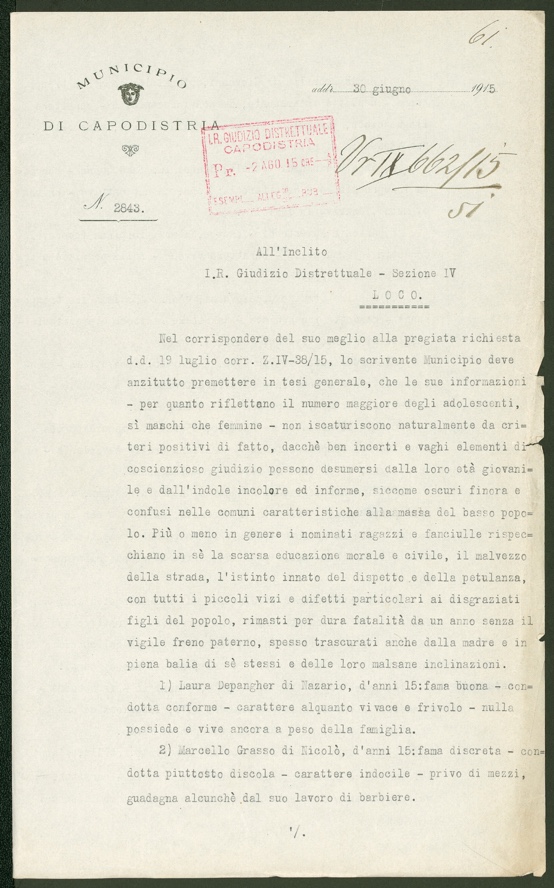
V Kopru so 23. aprila 1915 potekale demonstracije zaradi podražitve živil. Oropanih je bilo več lokalov in trgovin, nekatere izgrednike so privedli na sodišče, med njimi je bilo veliko mladoletnic in mladoletnikov. Med sodnim postopkom so oblasti izpostavile pomanjkljivo vzgojo otrok kot posledico odsotnosti očetov.
Vir: Archivio di Stato di Trieste.
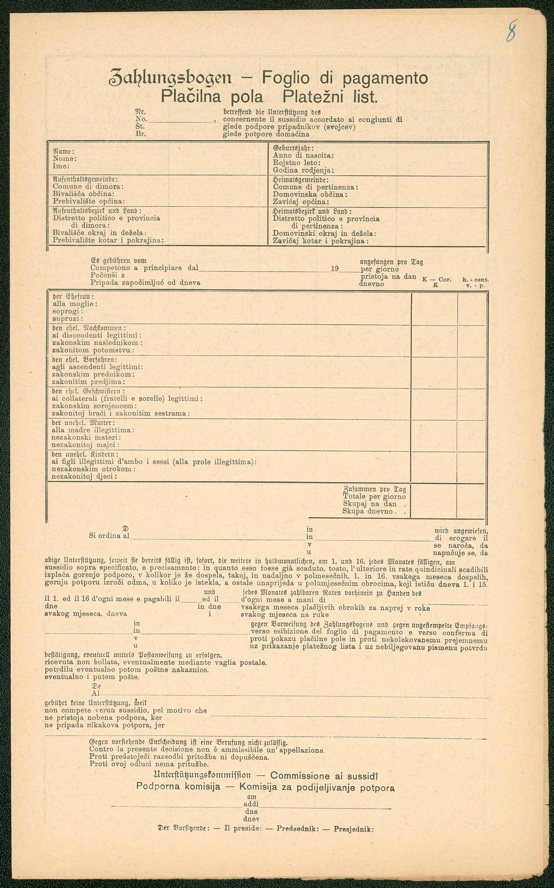
Prijavna pola za dobivanje državne podpore po zakonu z dne 26. decembra 1912, državnega zakonika št. 237.
Vir: Archivio di Stato di Trieste.

Stiska družine ob odsotnosti očetov.
Vir: Ilustrirani glasnik, 20. 9. 1917.
Odlomek iz pisma Matevža Demšarja svoji ženi Marjani, Trnovo pri Ilirski Bistrici,
9. avgusta 1914.
Vir: Loški razgledi, 1985.
»Draga žena: pred kot i nadalje pišem, vas vse skupej pozdravim in vam naznanim, da sem tista karta dobu, ali razomet pa nisem mogu, ker več puštob manka, da ne vem nič, kaj ste mi pisal druzega, kakor, da ste žito spravili; žito kar v kazuc denite, da se posuši in potem ga pospravite, kamor ga veste, ker jest ga skoraj gotovo mlatu ne bom letos. Novega vam ne vem kaj pisati, zdrav sem, hvala Bogu.«
Morality
The chaotic circumstances during the war, which saw traditional family ties were becoming looser due to the population’s increased mobility, encompassed the moral social order. The behaviour of men and women became more audacious and their sex life more promiscuous than in the pre-war period. The British press reported that young girls were “crazy” about men dressed in khaki. Many Slovene girls caught the “khaki fever” as well, particularly in the immediate proximity of the battlefield, where uncertainty and poverty were felt most acutely.
After the outbreak of the war the guardians of public morality once again voiced their concerns for the honour of women who were not controlled by men. Women’s immoral behaviour could pose a threat to the “national honour”. In Slovene ethnic territory, it was particularly the clergy who drew attention to sinful consequences of women’s indecent clothing, disorderly conduct, flirtation with soldiers, and, in general, inappropriate spending of the wartime
financial support.
Podeželske duhovnike je ob prihodu vojakov skrbela morala vaških deklet.
Vir: Nadškofijski arhiv Ljubljana.
»Društveno življenje sedaj počiva, ker nas zanima sedaj samo branje o vojski. Marijine družbe pa delujejo kot prej ali še bolj, ker je teren bolj mehak in torej lahko orjamo bolj na globoko. Samo vojakov se bojim k nam, ker je skušnja pokazala, da so nekatere punice tudi iz M. D. zares kar nore nanje. Pri zadnjem shodu sem glede tega izrazil svojo žalost … pa bolje je bilo šele tedaj, ko so vojaki odšli.«
Moralisti so opozarjali na 'pohujšljivo' žensko modo, neprimerno za resne vojne čase.
Vir: Bogoljub, št. 8, 1916.
»Ravno zdaj v času te groze – še hujše norosti kot prej /…/ mlade punčare se oblačijo tako, da so kakor opice /…/ z docela golimi bedri letajo po ulicah.«
Food
The shortage of the most basic foodstuffs brought about a profound change in the population’s eating habits. Due to the mainland blockade or restrictions of international trade it was becoming increasingly difficult to supply the most basic necessities after the opening of the Isonzo Front. Food was scarce particularly in the winter of 1915.
Calls for picking edible fruits and frugal use of foodstuffs, fuel, salt, oil, flour, and bread became part and parcel of everyday life during wartime. Bread and basic foodstuffs could be bought with food stamps. Along with the planned austerity measures and reduction of the volume of foodstuffs came also censuses and requisitions which had a negative impact on the rural population. The shortage caused an increase in the price of foodstuffs. Wheat flour was scarce. Bread, which was due to numerous additions becoming more and more difficult to digest, was referred to as Kriegsbrot, war bread. General shortage and soaring prices expedited the spread of smuggling, hiding food, state support frauds, price increase, thefts, etc. In most cases, it was women who were the perpetrators of these offences due to which they were often taken to court.
Vir: Ljudska hrana v vojni časih, Novi čas, 18. 3. 1915. (www.dlib.si)
»Vaši očetje, bratje in možje so v vojni. /…/ Žrtvujte se tudi Vi za domovino, za katero jemljejo naši junaški vojaki nase vsak dan tako velike žrtve. Vsakdo deluj za varčnost z zalogami naših živil in si tako prizadevaj, da se izkaže vrednega velike dobe.«
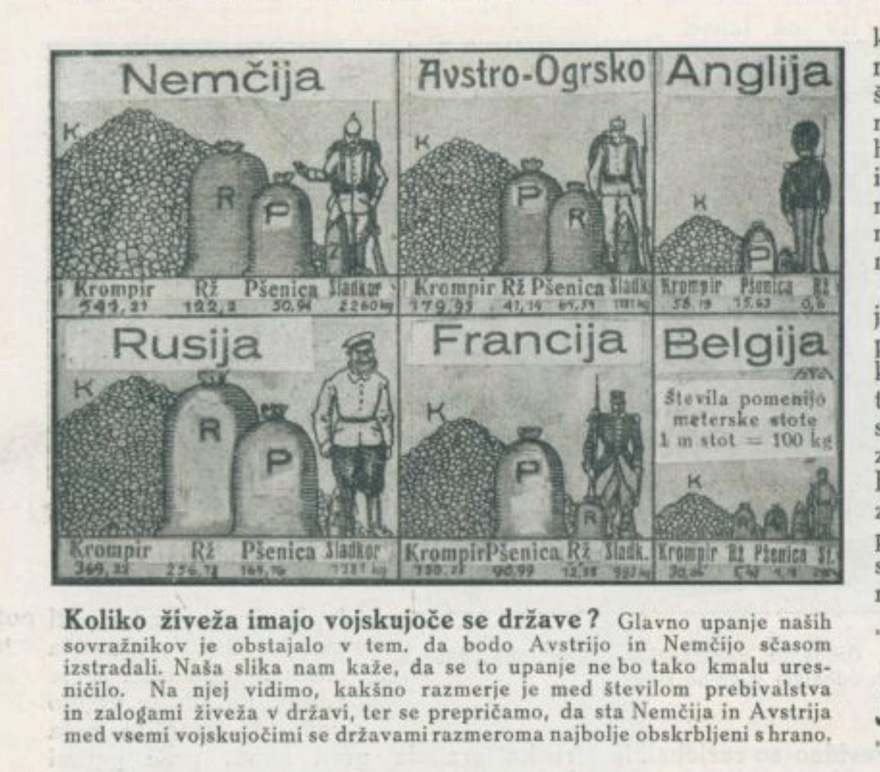
S propagandnimi prikazi zadostnih zalog hrane je država mirila prebivalstvo.
Vir: Ilustrirani glasnik, 11. 2. 1915. (www.dlib.si)
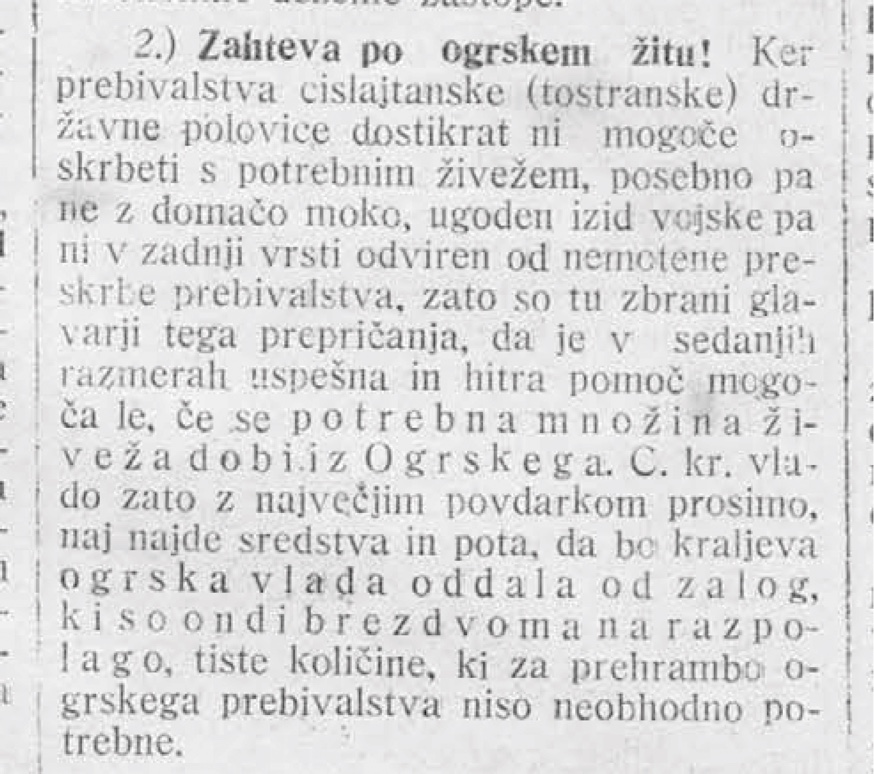
Nesoglasja med avstrijskim in ogrskim delom monarhije so se kazala tudi pri prehrani. Z žitom bogata rodovitna Ogrska ni hotela deliti zalog s čedalje bolj lačnim avstrijskim delom.
Vir: Novi čas, 18. 3. 1915. (www.dlib.si)
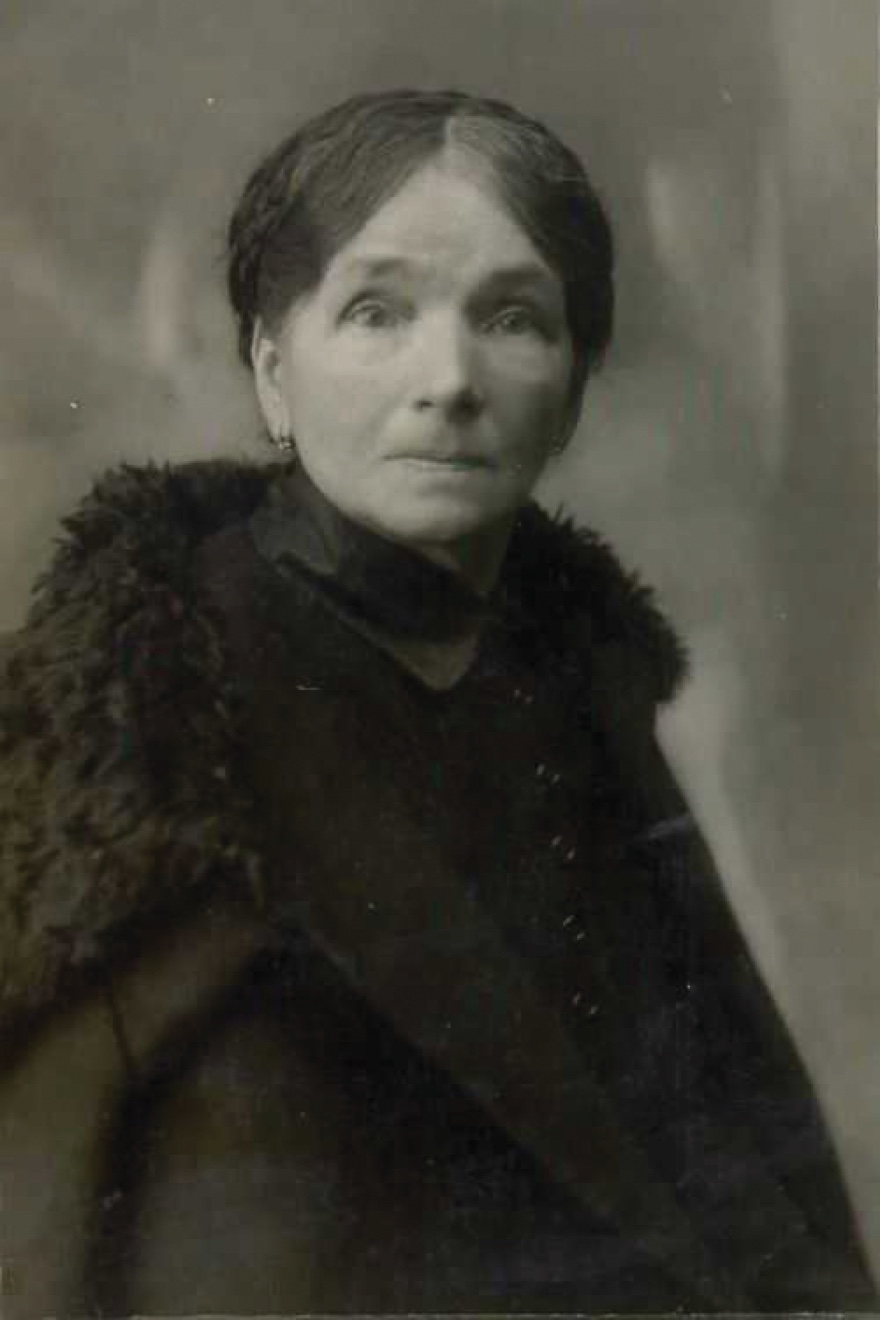
Marija Remec (1869–1956), avtorica Varčne kuharice (1915).
Vir: Narodna in univerzitetna knjižnica, Ljubljana.
Nursing auxiliaries
Following the outbreak of the war, women started to volunteer their services with the Red Cross. Its ranks included noblewomen and bourgeoisie, partly also peasants and labourers, who organized themselves within it despite the scepticism that was felt throughout Europe and on both sides of the Italian-Austrian front on account of women’s involvement “in the service of the war”. It was noticeable already in the first months of the conflict that care provided by women members of the Red Cross was of utmost value to the wounded. If on the outset of the war health workers were still kept in the background, the lack of medical staff and the severity of conflicts soon resulted in nurses and nursing auxiliaries being active also in the immediate proximity of the firing line, in mobile medical and surgical units. They also provided care on trains that took the wounded to the state’s interior.
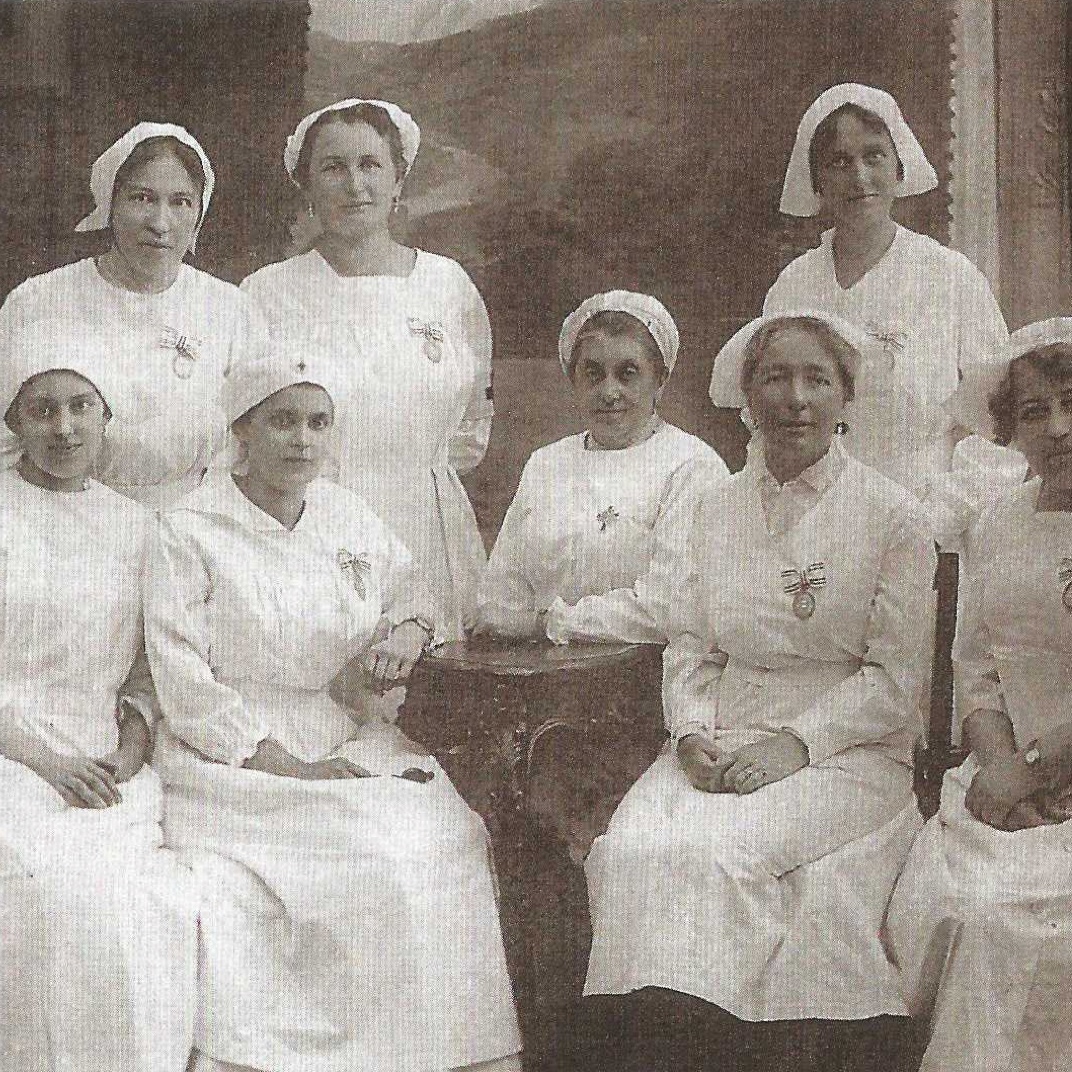
V Rdečem križu dežele Kranjske so bile še posebno dejavne plemkinje in pripadnice ljubljanske meščanske elite. Na fotografiji so Barbara Laschan pl. Moorland (sedi v sredini) s hčerko Sofijo baronico Sommaruga (sedi skrajno levo). Od leve zgoraj: gospa Paulin, Helena Bretl (vdova Naglas) in gospa Šarabon. Spodaj skrajno desno: Rosy Bleiweis pl. Trsteniški (roj. Souvan), Berta Triller. Druga z desne je neznana.
Vir: Mariano Rugàle, Miha Preinfalk, Blagoslovljeni in prekleti, I. del, 2010.
Vir: Evgen Lampe, Dnevniški zapiski dr. Evgena Lampeta: 1898–1917, 2007.
»Na začetku vojne je v ljubljanskem Rdečem križu prihajalo do trenj med slovenskimi in nemškimi članicami društva: »Dr.Triller se je pritoževal, da so njegovo ženo šikanirali, ko je v licej češkim ranjencem za priboljšek prinesla buhteljnov. /…/ Gospa Högler pa naj bi pri sprejemu na kolodvoru ranjencu, ki se ji je zahvalil, odgovorila: 'Windisch wird hier nicht verstehen!'« Gospa Högler je bila primorana zapustiti Rdeči križ, potem ko »je nekoč letala zopet okoli ranjencev s cigaretami in izpraševala, kje so Nemci, je naletela na nekega Čeha. Ko ji je rekel, da je Čeh, mu ni hotela dati. Nato je pristopil nek častnik, ji s sabljo odrezal trak z rdečim križem z rokava in jo zapodil.«
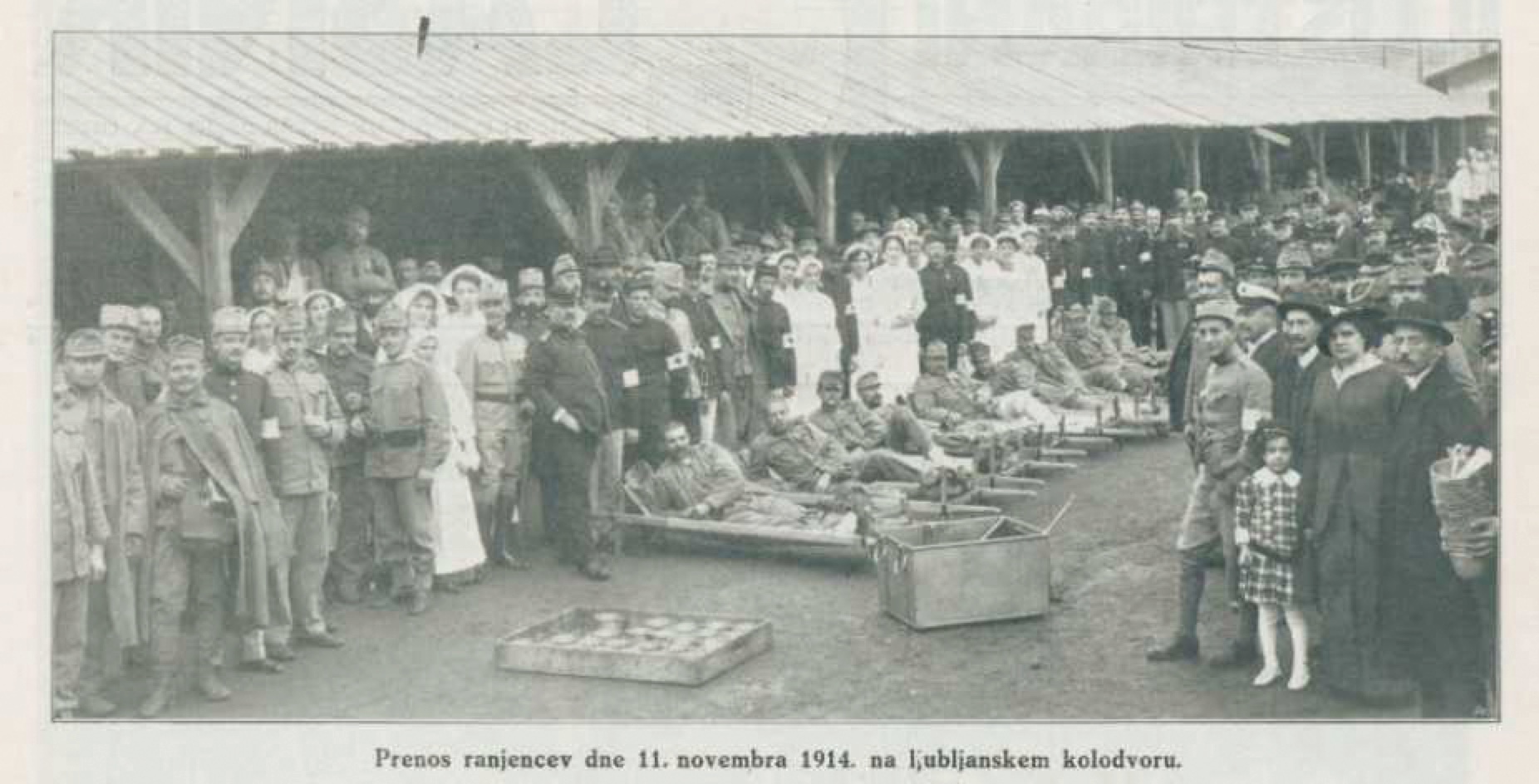
Prenos ranjencev na ljubljanskem kolodvoru. Evgen Lampe je v svojem dnevniku komentiral: »Dame, ki pridejo k sprejemu ranjencev, so bolj na poti kot za pomoč.«
Vir: Ilustrirani glasnik, 17. 12. 1914. (www.dlib.si)
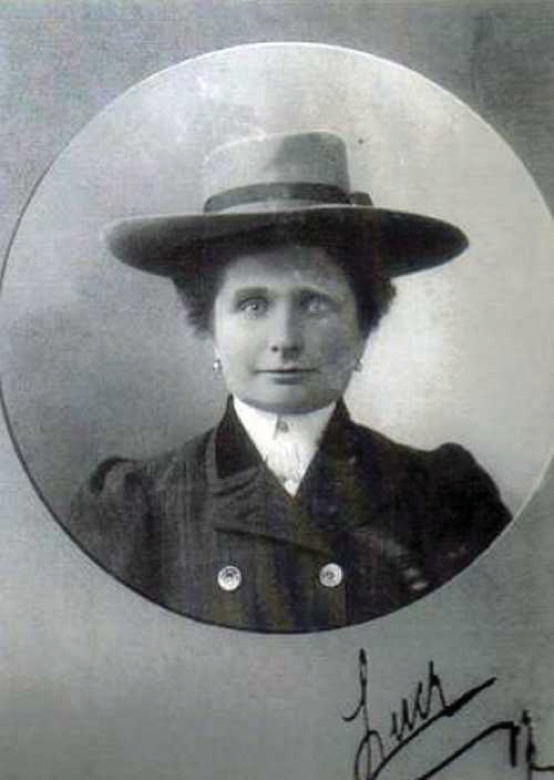
Lucy Christalnigg (1872–1914), rojena Bellegarde, je bila avstrijska plemkinja, grofica, dirkalna voznica in odbornica Rdečega križa. Bila je prva žrtev prve svetovne vojne v Soški dolini in na Slovenskem. Trinajst dni po začetku prve svetovne vojne, 10. avgusta 1914, sta jo na poti iz Celovca v Gorico na Brezovem pred Srpenico v dolini Soče ustrelila domačina, ker na ukaz patrulje ni ustavila avtomobila. V njem je grofica prevažala blago Rdečega križa.
Vir: sl.wikipedia.org
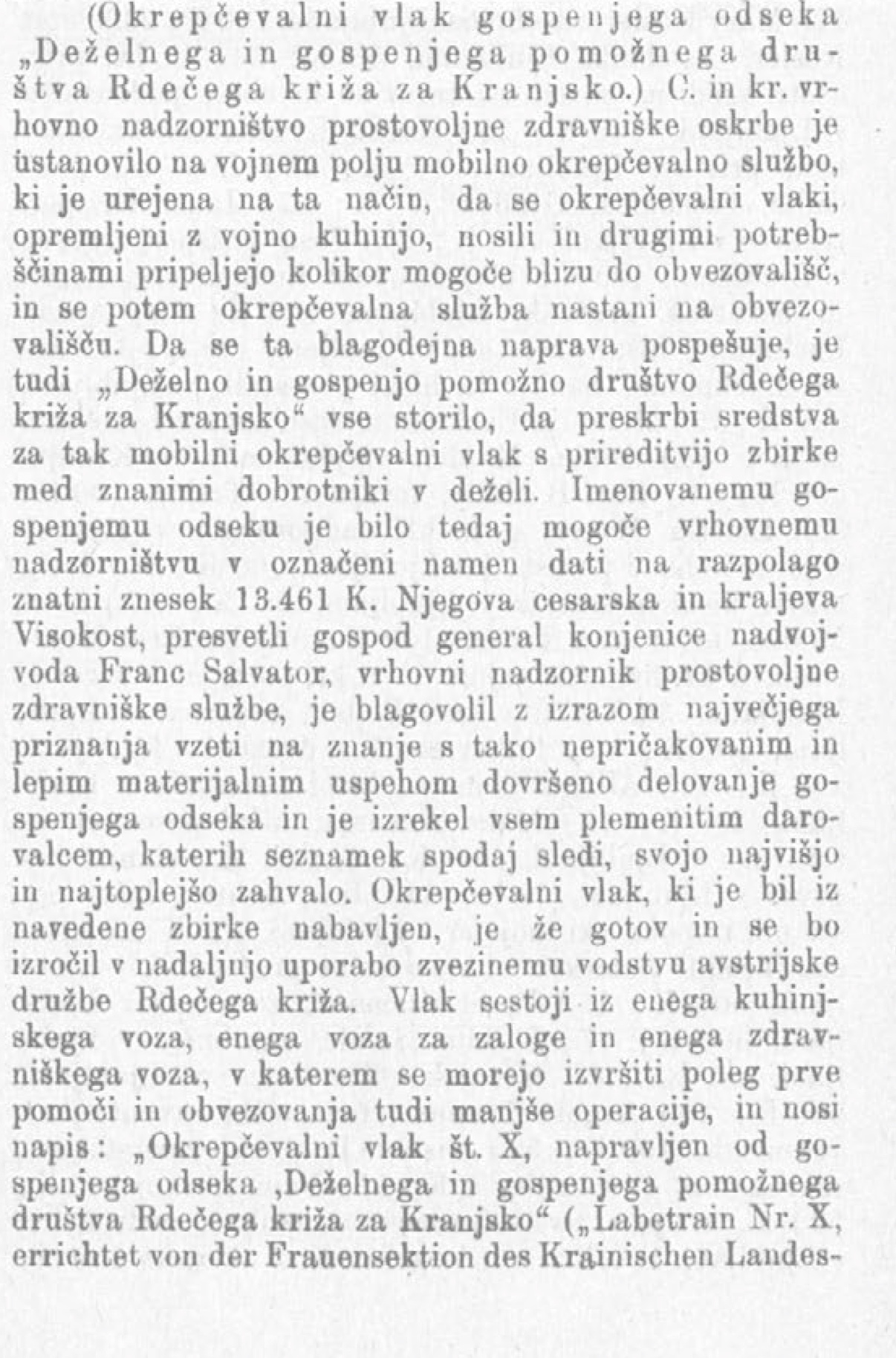
V času vojne se je v Ljubljano vrnila tudi najbolj prominentna ljubljanska Nemka Lina Kreuter Galle, ki je spodbudila ljubljanski Rdeči križ, da je začel zbirati sredstva za 'okrepčevalni vlak'.
Vir: Okrepčevalni vlak gospenjega odseka 'Deželnega in gospenjega pomožnega društva Rdečega križa za Kranjsko', Domačin, 10. 4. 1915. (www.dlib.si)
Education
Many teachers were conscripted at the beginning of the war. School authorities replaced them with women apprentices, who followed children into refugeeism after May 1915. The opening of the Isonzo Front disrupted the teaching process in the areas that were in the immediate proximity of the firing line. The number of wounded soldiers in Slovene provinces underwent a considerable increase owing to the proximity of the front. School premises were confiscated for military requirements. The number of wounded soldiers that required medical assistance and care grew already after the first conflicts; consequently, many schools in the hinterland were turned into hospitals. Nursery schools were abolished, lessons were held in attics or privately owned houses.
In schools in the hinterland, children were involved in many activities that aimed to spread the patriotic atmosphere and provide moral support to those engaged in combat. By writing holiday cards, knitting socks, drying fruit, gathering metals, schoolchildren and students proved their integration in the “total war”.
Iz pisma Olge Šlebinger, roj. Simonič mami Rozi, 30. januarja 1915. Olga je bila poročena z Jankom Šlebingerjem, ki je v času prve svetovne vojne delal kot profesor na državni višji realki, pozneje pa je postal bibliograf, urednik, literarni zgodovinar in prvi ravnatelj Narodne in univerzitetne knjižnice v Ljubljani.
Vir: Barica Marentič Požarnik, Babičina beseda. Izdano v spomin ob 10-letnici smrti, 1977.
»Vojska pa se občuti pri vsakem koraku. Izmed Jankovih kolegov so šli zdaj spet v vojsko, tako da je od lanskih 24 učnih moči ostalo le še osem. Nadomestili pa jih bodo vse s poljskimi profesorji – begunci. Tako za zdaj šola še ne bo zaprta /…/ Bil je lep, jasen dan in otroci so zdravi in veseli. Nič ne vedo za naše skrbi, imajo vse, kar je treba, in skačejo, da je veselje.«
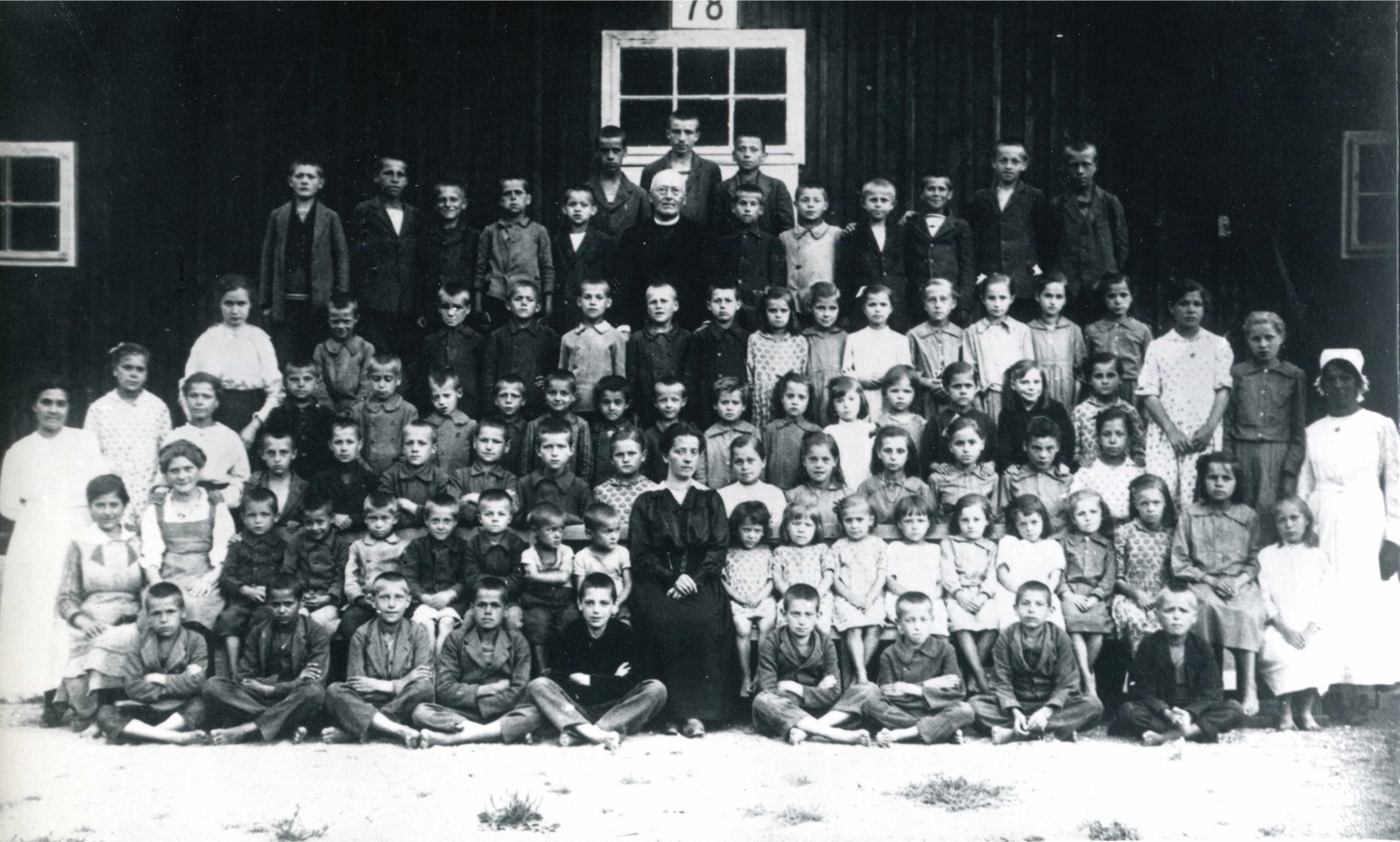
Otroško zavetišče v Steinklammu v Spodnji Avstriji med St. Pöltnom in Amstettnom leta 1918.
Vir: Slovenski šolski muzej.
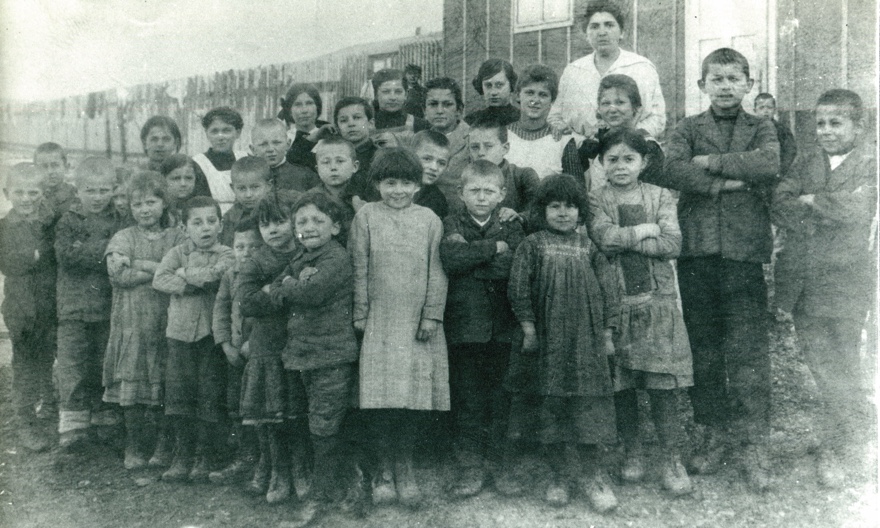
Begunski šolarji z učiteljico Drago Medic pri pouku na prostem v Raschali v Spodnji Avstriji, severno od Dunaja, leta 1916.
Vir: Slovenski šolski muzej.

Učni krožek z učiteljico Pavlo Makuc v otroškem zavetišču v Steinklammu v Spodnji Avstriji.
Vir: Slovenski šolski muzej.
Women’s Labour Market
In the second year of the war the European economy adjusted to the military requirements. The industry produced for the army. Due to the lack of the male workforce women also started to take over hard manual work. The portion of women in jobs that were traditionally done by men increased almost throughout the monarchy, even though differences between individual provinces could be considerable. The situation in Italy and elsewhere in Europe was similar.
In Slovene provinces, where industry was poorly developed and smaller workshops prevailed, the employment of women in non-traditional occupations lagged behind other Austrian regions (Vienna, Bohemia, Vorarlberg). The proximity of the Isonzo Front impacted also the labour market in Carniola and Lower Styria, as these areas were considered to be to a risk in terms of establishing an intensive military production. The changes in employing women were initially most noticeable in service activities and the trade sector, particularly in hospitality industry and sales jobs. An increasingly larger number of women, most of all refugees, worked for the military requirements.
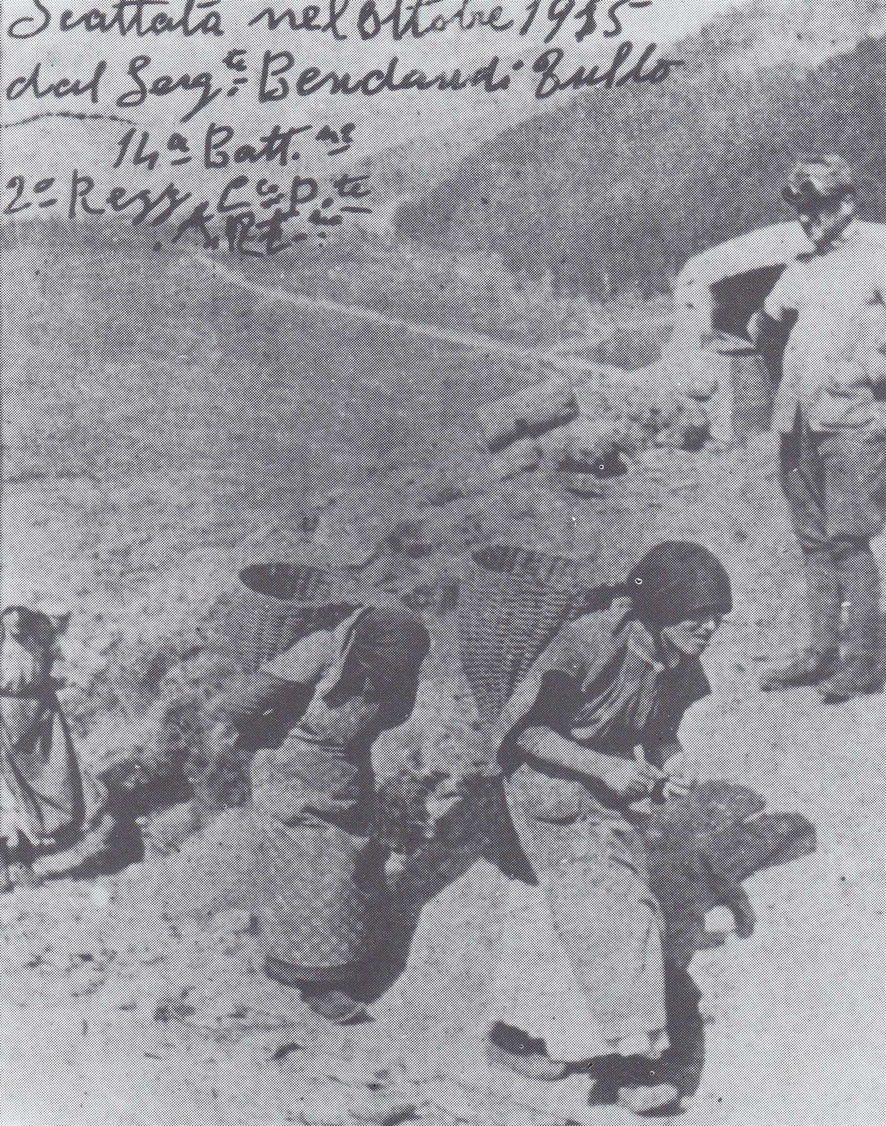
T. i. karnijske prinašalke so na vojaške položaje v dolomitskem visokogorju v zameno za plačilo nosile v koših do 40 kg različnih dobrin in streliva. Obstajajo pričevanja o podobnih dejavnostih žensk za vojaške postojanke na Kolovratu.
Vir: Le Portatrici Carniche, 2005.
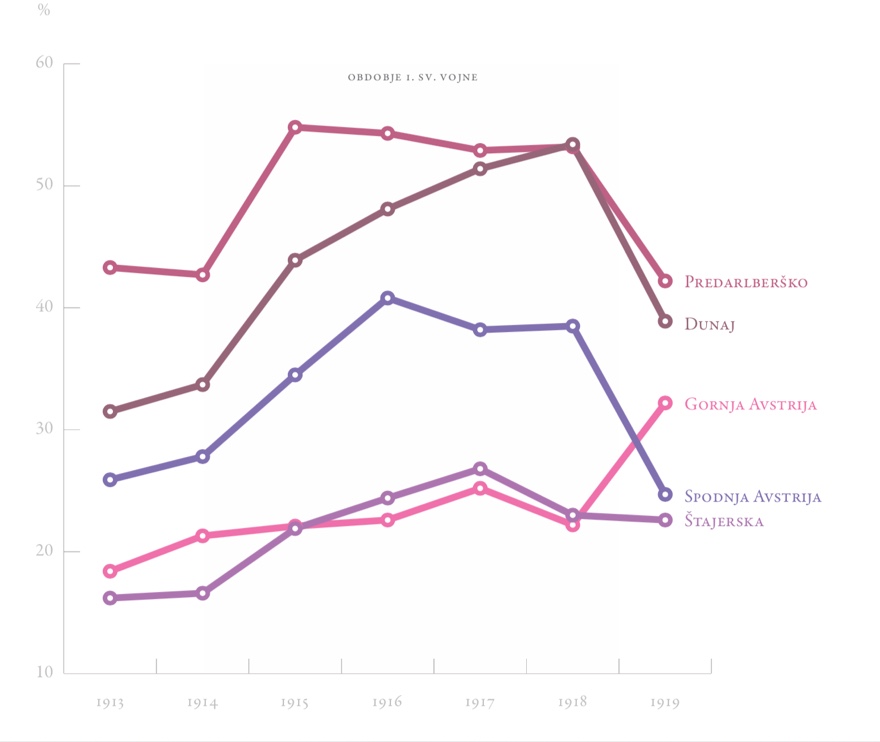
Graf prikazuje različne deleže zaposlenih žensk v izbranih avstrijskih deželah med letoma 1913 in 1919.
Vir: Sigrid Augeneder, Arbeiterinnen in Österreich, 1982.
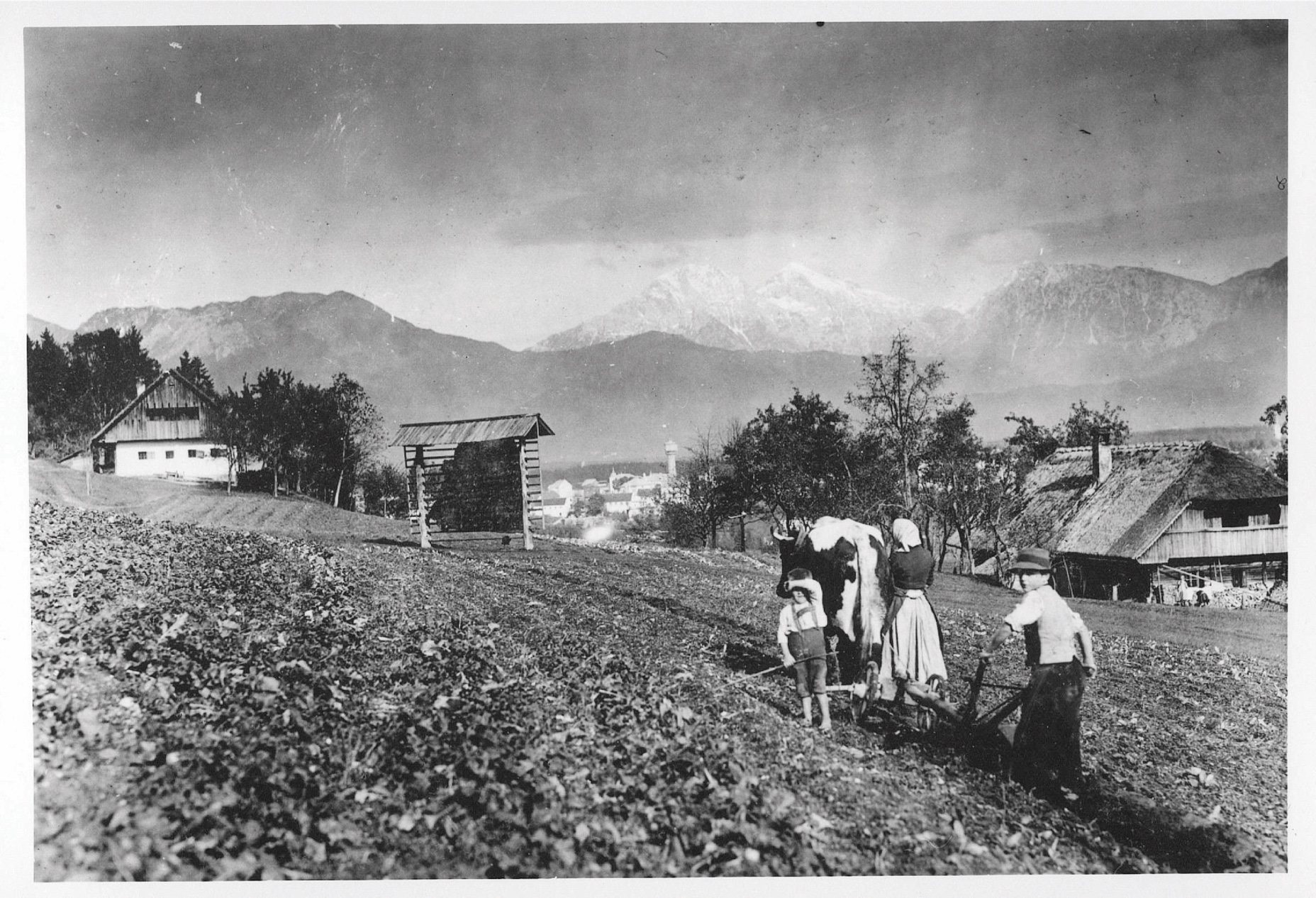
Večina žensk na Slovenskem se sprva ni aktivno vključila na trg delovne sile. Pomanjkanje hrane je povzročilo trend selitev na podeželje, kjer so se ženske zaposlovale v kmetijstvu.
Vir: Muzej novejše zgodovine Slovenije.

Šele proti koncu leta 1915 so se na državnem nivoju začele bolj množično in sistematično oblikovati pobude o mobilizaciji žensk v Avstriji s posebnim poudarkom na ženskem delu.
Vir: Slovenec, 20. 12. 1915. (www.dlib.si)
War Propaganda
Each warring state organised its own propaganda machine during World War I, by means of which it convinced its citizens of the correctness of its actions and instigated patriotic atmosphere among the female population. The military apparatus that controlled and directed the media took care of efficient censorship. In the military propaganda discourse, women appeared as victims of the hostile army, as allegorical figures – in France as Marianne, in the United Kingdom as Britannia – who appealed to men to join the army.
Women depicted on postcards and posters encouraged soldiers to defend their homes from brutal and immoral enemies. In order to promote the public’s negative disposition towards the enemy the propaganda made use of rapes and assaults of women perpetrated by the enemy. It urged women to contribute to the military success by being frugal, writing letters to soldiers on the front, gathering means for the army, finding employment in the production, in support units, and
medical institutions.
Vir: Vili Prinčič, Pregnani: prva svetovna vojna. Pričevanja goriških beguncev, 1996.
»Po tednu dni so nas strpali v vlak in odpeljali v Ivreo, manjše mesto severno od Turina, kamor smo prispeli zvečer. /.../ Naslednji dan zjutraj smo bili priča nenavadnemu prizoru. Pred šolo se je namreč zbrala vsa vas, da bi videla te čudne ljudi. Šele kasneje smo izvedeli pravi vzrok. Plakati po mestu so namreč prikazovali Avstrijce s parklji in rogovi.«
— Jožef Primožič
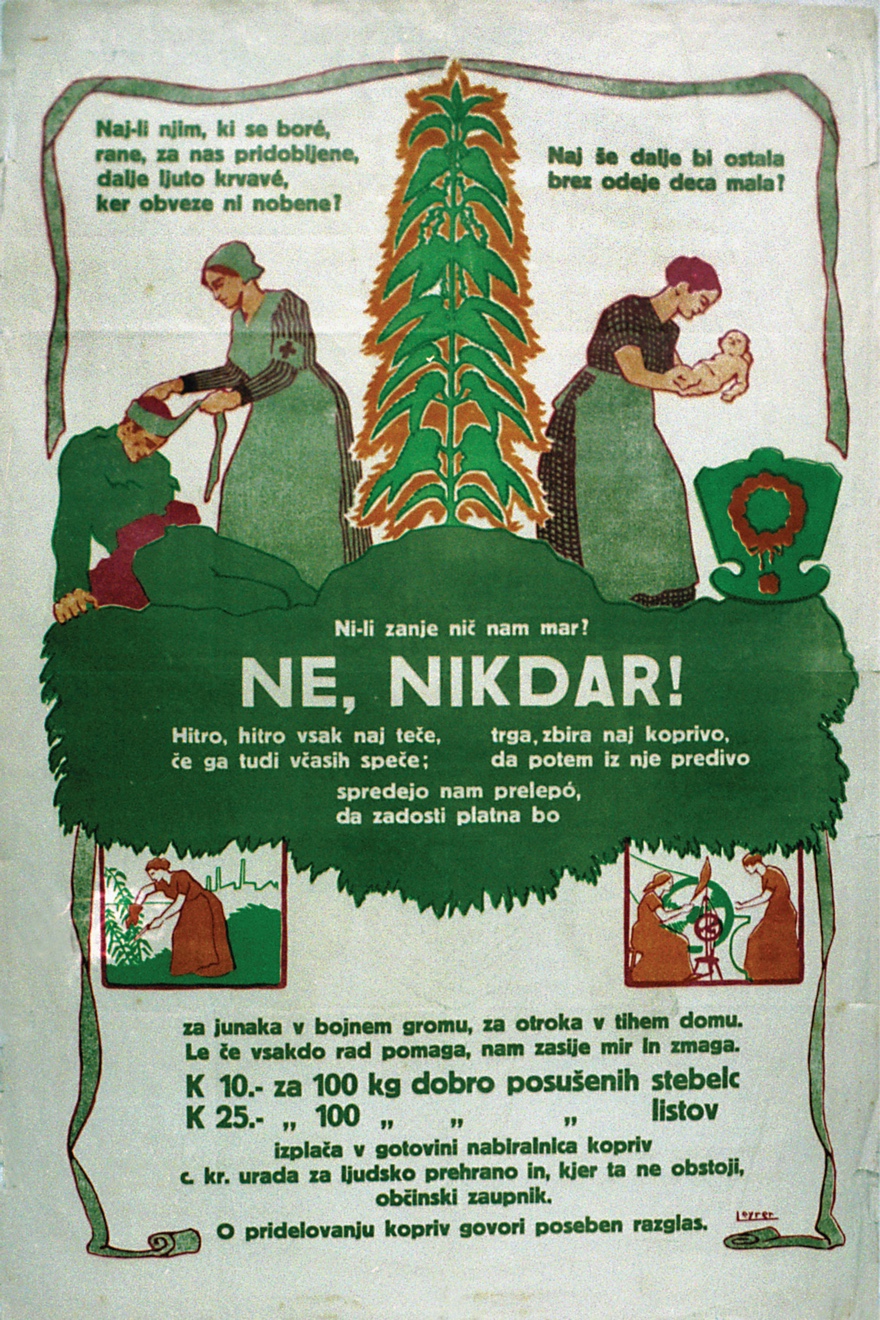
Razglas, ki poziva ženske proti plačilu k nabiranju in sušenju kopriv za vojne namene.
Vir: Muzej novejše zgodovine Slovenije.
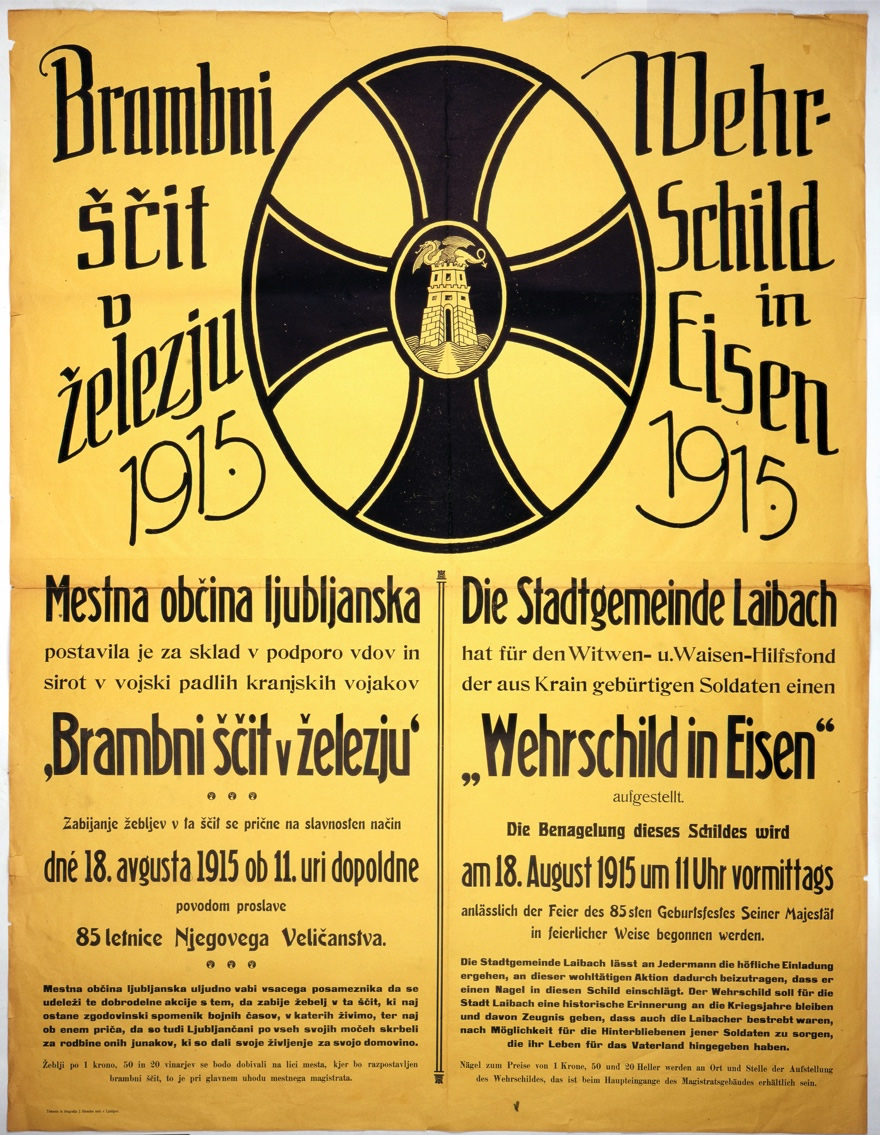
Razglas občine Ljubljana za dobrodelni dogodek 'Brambni ščit'.
Vir: Muzej novejše zgodovine Slovenije.
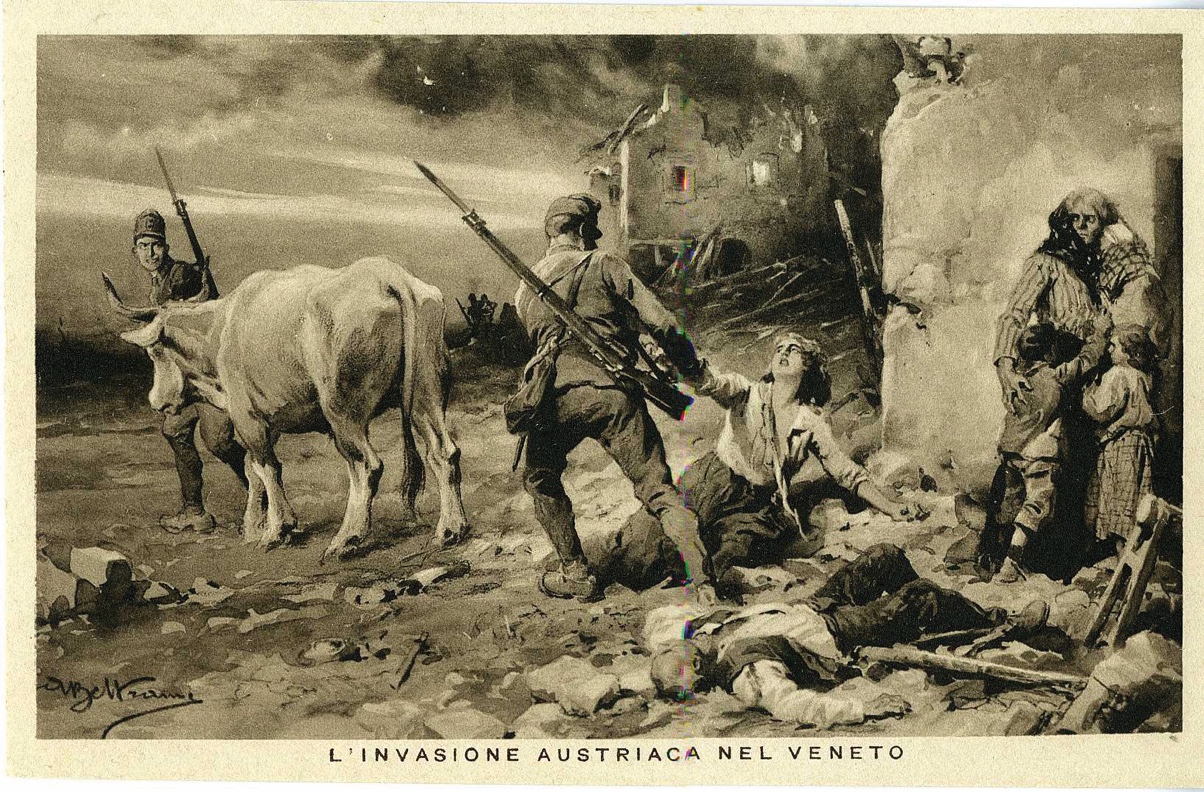
Italijanska razglednica, ki prikazuje ravnanje avstro-ogrske vojske s civilnim prebivalstvom v Venetu po 12. soški ofenzivi.
Vir: Muzej novejše zgodovine Slovenije.
Women’s Criminality and Subversive Activities
Faced with the nature of the total war, women had to adjust swiftly to wartime; nevertheless, some of them defied the severe circumstances of wartime absolutism. The criminality rate among women underwent a considerable increase during wartime. The authorities persecuted women on grounds of their non-patriotic behaviour, Serbophilia, Russophilia, defamation of the emperor, and pacifist viewpoints. Women’s violation of law and regulations (thefts, frauds, opposing to regulations, falsifying documents, etc.) often stemmed from difficult material circumstances and the need for survival.
The shortage and poor provision of life’s necessities resulted in their participation in both peaceful demonstrations and riots in 1915. In many cities of the Habsburg Monarchy, in Vienna, Ljubljana, Maribor, Trieste, and Koper, they took to the street demanding from the state a just provision and financial support.
Between 28 April and 1 May 1915, women representatives of conflicting armies gathered at the Hague Peace Congress and demanded the end of the military activity.
Vir: Poldka Kos, Nekaj spominov iz mojega življenja, v: Idrijski razgledi, št. 1, 1968. (www.dlib.si)
»V službo sem se vrnila šele čez poldrugo leto, toliko časa je namreč trajala disciplinska preiskava. Medtem sem dobivala le polovično plačo, kar je bilo zelo malo, saj je cela plača komaj zadostovala za preživljanje. Nazadnje so me kaznovali z ukorom, ker naj bi bilo moje obnašanje tako, da bi bilo moglo vzbuditi sum v moj patriotizem.«
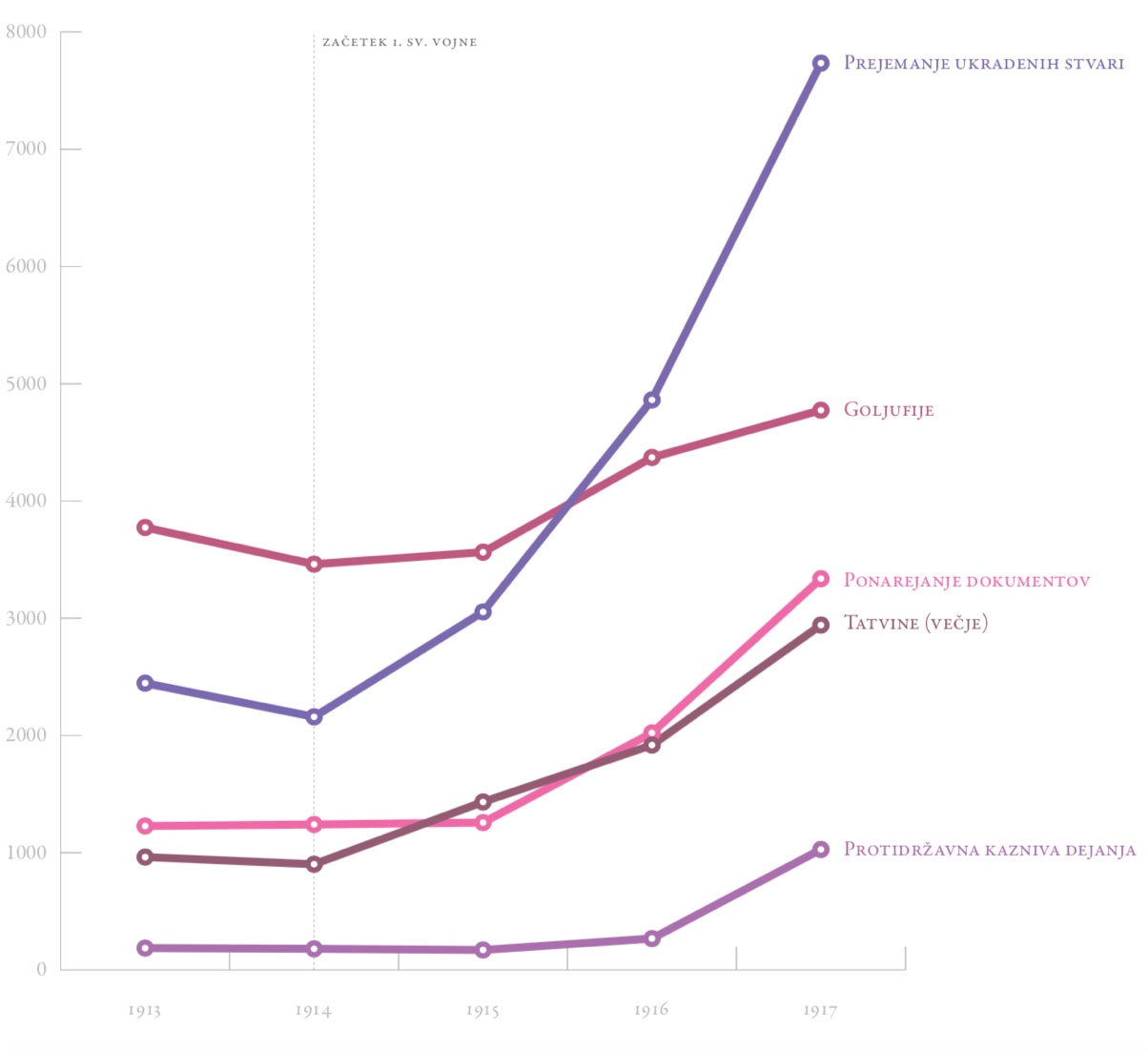
Gibanje števila ženskih kaznivih dejanj v Nemčiji med letoma 1913 in 1917.
Vir: Sebastian Von Koppenfels, Die Kriminalität der Frau im Kriege, 1926; Ute Daniel, The War from Within – German Working-Class Women in the First World War, 1997.
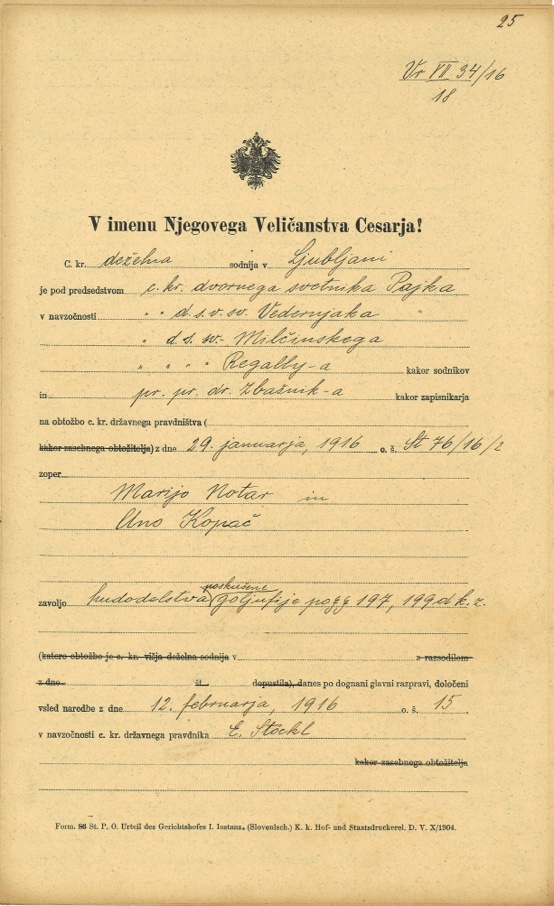
72-letna Marija Notar iz Škofje Loke in 52-letna Ana Kopač iz Preske sta novembra 1915 v Medvodah orožnikom pokazali neveljavni identifikacijski potrdili in si s tem prislužili 10-dnevno ječo.
Vir: Arhiv republike Slovenije.

Vir: Slovenski narod, 5. 3. 1918. (www.dlib.si)
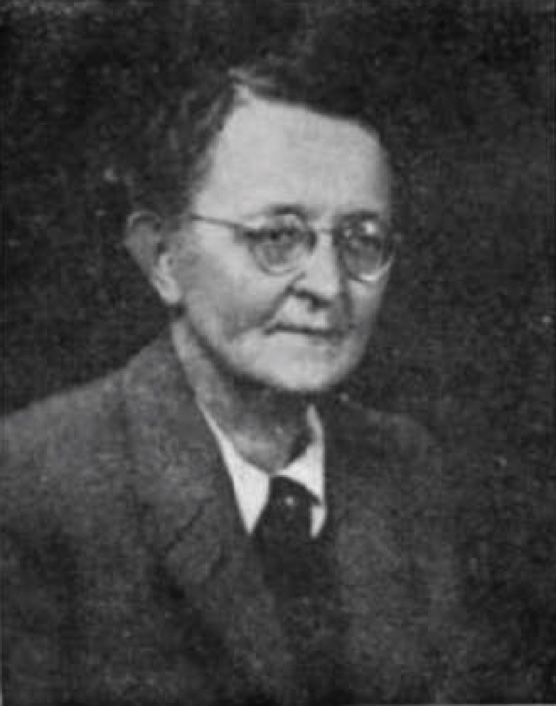
Leopoldina Kos (1889–1968).
Vir: Idrijski razgledi, št. 4, 1959. (www.dlib.si)
A Man’s and a Woman’s View
Millions and millions of letters travelling daily back and forth, from the hinterland to the front conveyed soldiers’ experiences, fears, desires, feelings and hopes, but also those of their families, acquaintances, and, last but not least, of those who supported them during combat. Thoughts and words expressed by men and women resounded in the great “paper” war. Letters were penned by sons, fathers, brothers, who went on to war, mothers, sisters, fiancées, and wives, who stayed at home or were forced to become refugees. The majority of extant correspondence was written by men; nevertheless, letters penned by women have been preserved as well. Wartime diaries were typically written by soldiers, who at times spoke about women. The war experience, which made a clear distinction between “our troops” and the opponent in the battlefield, imposed an increasingly more rigid dividing line between men and women.
In their intimate writings, soldiers remembered their mothers, fiancées, and wives with fondness; meanwhile, they frowned upon women whom they saw in the immediate proximity of the front, particularly if they socialized with soldiers. They treated them as if they were worthless, dangerous spies, harlots. If some diarists were genuinely concerned about their mothers, wives, fiancées, sisters because they feared for their livelihood and social status, which was shaken by the material uncertainty during wartime, individual women wrote about their worries concerning their partners’ exposure to various hazards and temptations. They complained about the ongoing situation and the loss of intimacy. Diarists often expressed their disappointment at their fiancées who failed to put themselves in their position and recognise the cruelty of the war experience and did not provide the best support to men, who had been pushed into the trenches by the war.
Ivan Zupan, 19. 10. 1916.
Vir: Ifigenija Simonovič et al. (ur.), Vitomil Zupan: Važno je priti na grič. Življenje in delo Vitomila Zupana (1914–1987), 2014.
»Nekaj Tvoje pošte precej danes prejel. Neprijetno, da ne dobiš podpore od države ali jaz sem te redno opozarjal, hrani, dokler je čas, jaz vendar ne pošljem denarja, da se sproti porabi. Glej, da izhajaš kakor druge. Ta mesec bom skušal več poslati, ker imam kot kor. tudi več dohodkov … Ampak ne piši mi tako obupnih pisem. Saj vendar še ni vseh dni konec.«
Pismo Franca Rueha, 26. 8. 17.
Vir: Franc Rueh, Moj dnevnik 1915–1918, 1999.
»Tvoja prijateljica Špan se je precej zanimala v zadnjem času za to, kako jaz tukaj živim, ali sem Ti popolnoma zvest, itd. Čudni pojmi, ali ne? Saj v teh hribih, ko cele dneve hoda ni nobenega ženskega bitja, sploh ne bi bilo drugače mogoče, kot da sem ti zvest.«
Pismo Marije Grbec, 18. 5. 1915.
Vir: Pokrajinski arhiv v Novi Gorici.
»Bog nam more pomagati v teh strašnih razmerah sedanjega časa – to pa storimo kolikor mogoče, vsaki večer in vsako jutro ko molimo skupaj, potem če gre kdo k sv. maši ali k šmarnicam se vsakokrat spomnimo tudi na vas uboge trpine, in črez dan se tudi vedno spominjamo na vas. In tudi zdaj ko je začela šestnedeljska pobožnost v čast sv. Alojziju tudi takrat vedno kaj prihranimo za vas reveže – torej potem takem trdno upamo, da se bo dobro izšlo. Tukaj so zdaj začeli prerokovati o miru in tudi res kaže, da bo, ker našim gre prav dobro in prodirajo vedno naprej.«
Vir: Ilka Vašte, Podobe iz mojega življenja, 1964.
»Nekaj mesecev pozneje smo imeli neko dobrodelno prireditev pri pogrnjenih mizah v veliki dvorani Balkana. Sedela sem v večji družbi znancev in prijateljev. Moj mož je nastopal na odru kot solist in v zboru. Imel je bariton čudovite lepe barve. V odmoru je prišel k meni in mi prišepetal:
'Ozri se tja na drugo stran! Glej, žena dr. Žerjava, ki so ga kot srbofila in avstrijskega izdajalca zaprli, sedi tam pri veliki mizi popolnoma sama. Ali bi se ji hotela pridružiti? Kar sram me je, da jo pustijo samo sedeti, strahopetci!'
Moj mož sicer ni bil politični somišljenik dr. Žerjava, toda poznal ga je osebno … 'Seveda se presedem k njej! Le predstaviti me moraš, ker ne vem, če se me še spominja iz Ljubljane. Telovadili sva skupaj.'
'Prav, kar oprosti se tukaj in pridi!'
Storila sem, kakor je želel. Kako tudi ne! Saj sem bila še vedno - očetova hči!
Sedela sem ves večer pri izobčenki. /.../ Ko sva se po koncertu poslovili, mi je prisrčno stisnila roko in se mi zahvalila za družbo z običajno frazo, prišepetala pa mi je: 'Nikoli vam tega ne pozabim.'«
Civilian Population
after the Opening
of the Isonzo Front
On Pentecost Sunday, on 23 May 1915, Italy declared war to its former ally Austria-Hungary. On that very night, Italian troops crossed the border. The more than 90-kilometre long Isonzo Front, the scene of the bloodiest battles between the Italian and Austro-Hungarian army, was formed between Apine peak of Rombon and the Gulf of Trieste.
The population of the area along the river Soča experienced the first year of the war mostly through mobilization and militarization of the everyday life; with the formation of the Isonzo Front the war reached the native soil. The civilian population of the Soča region joined 15 million civilians who ended up in exile and poverty in different parts of Europe and Turkey but also became victims of violence and interethnic hostilities due to military operations.
A crowd of 100,000 refugees, which included alongside the population of the Soča Valley also Istrians of both genders, was the consequence of the evacuation of the area in the immediate proximity of the battlefield. The forced departure was on the Austrian side completed in chaos and haste. Pouring into the streets and railway stations with life’s necessities, frightened people, mostly women, children, and the elderly, left their homes from the end of May onwards. Some of them could rely on the help of their relatives and benefactors who lived in the hinterland citied. The majority of them was sent to the monarchy’s interior by the Austrian authorities, where refugee camps were set up. Refugees in the Italian-occupied area were put up in various towns of the Apennine Peninsula.
»Začetek vojne smo doživeli v trenutku, ko našega očeta ni bilo doma. Naš primer ni bil osamljen, saj so razen redkih izjem vse družine ubrale pot begunstva brez svojih družinskih poglavarjev. Naše skrbne in hrabre mame so morale torej same nositi težo odgovornosti za preživljanje družin, v kateri so po navadi prevladovali mladoletni otroci, velikokrat celo dojenčki. Zlasti je bilo hudo za tiste družine, ki so se znašle na desnem bregu Soče, na takoimenovanem 'goriškem mostišču', tj. v vaseh Oslavje, Pevma, Štmaver, Podgora in Ločnik. Čez noč smo postali del prve vojne črte! Pred sabo smo imeli prodirajočo italijansko vojsko, za sabo Sočo.«
Pepca Gravner, Oslavje, 1911.

Kraji v Italiji in Avstro-Ogrski, v katerih so živeli begunci iz Goriškega.
Vir : Vili Prinčič, Pregnani: prva svetovna vojna. Pričevanja goriških beguncev, 1996.











